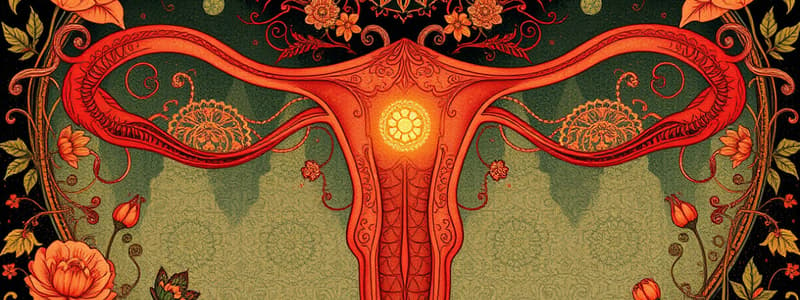Podcast
Questions and Answers
Ovulation occurs on day 14 of the menstrual cycle.
Ovulation occurs on day 14 of the menstrual cycle.
True (A)
The fertile period spans days 5 to 9 of the menstrual cycle.
The fertile period spans days 5 to 9 of the menstrual cycle.
False (B)
Progesterone is responsible for building up the endometrium after ovulation.
Progesterone is responsible for building up the endometrium after ovulation.
True (A)
Menarche is the term used for the end of a woman's reproductive life.
Menarche is the term used for the end of a woman's reproductive life.
During days 21 to 28, if fertilization does not occur, the corpus luteum breaks down.
During days 21 to 28, if fertilization does not occur, the corpus luteum breaks down.
The endometrium breaks down and is passed out of the body only if pregnancy occurs.
The endometrium breaks down and is passed out of the body only if pregnancy occurs.
Human chorionic gonadotrophic hormone (hCG) is produced by the pituitary gland.
Human chorionic gonadotrophic hormone (hCG) is produced by the pituitary gland.
Follicle-stimulating hormone (FSH) is responsible for stimulating the development of a primary oocyte into an ovum.
Follicle-stimulating hormone (FSH) is responsible for stimulating the development of a primary oocyte into an ovum.
Oestrogen produced by the developing Graafian follicle helps repair and thicken the endometrium.
Oestrogen produced by the developing Graafian follicle helps repair and thicken the endometrium.
The surge in luteinising hormone (LH) occurs before ovulation.
The surge in luteinising hormone (LH) occurs before ovulation.
Negative feedback from oestrogen reduces the production of luteinising hormone (LH).
Negative feedback from oestrogen reduces the production of luteinising hormone (LH).
The corpus luteum produces progesterone after ovulation.
The corpus luteum produces progesterone after ovulation.
The menstrual cycle is directly tied to the fertilization of an egg.
The menstrual cycle is directly tied to the fertilization of an egg.
Luteinising hormone (LH) is involved in the feedback regulation of FSH production.
Luteinising hormone (LH) is involved in the feedback regulation of FSH production.
The endometrium is completely maintained during the menstrual cycle without the presence of hormones.
The endometrium is completely maintained during the menstrual cycle without the presence of hormones.
Flashcards are hidden until you start studying
Study Notes
Physical Development Differences
- Males experience voice deepening, shoulder broadening, increased muscle mass, and growth of facial, pubic, and underarm hair.
- Females undergo breast enlargement, hip widening, development of pubic and underarm hair, and thickening of subcutaneous fat, resulting in a more rounded figure.
- Estrogen is the primary hormone in females, while progesterone maintains the endometrium and prevents uterine contractions.
The Menstrual Cycle
- The menstrual cycle begins at puberty (ages 9-15) and includes the menarche, marking the start of a woman’s reproductive life, continuing until menopause (late 40s to early 50s).
- Menstruation occurs on day one and lasts four to five days.
- Day five marks the buildup of the endometrium, preparing for a fertilized egg, stimulated by estrogen from the Graafian follicle.
- Days nine to fifteen represent the fertile period, with day fourteen being ovulation when the Graafian follicle bursts and releases an egg.
- Follicle- stimulating hormone (FSH) and luteinising hormone (LH) spike before ovulation, causing ovulation.
- From days fifteen to twenty-one, the empty follicle transforms into the corpus luteum, secreting progesterone to prepare the endometrium for embryo implantation.
- If fertilization does not occur during days twenty-one to twenty-eight, the corpus luteum breaks down and progesterone production ceases, leading to endometrial degeneration and eventual menstruation.
- If fertilization occurs, human chorionic gonadotrophic hormone (hCG) maintains the endometrium.
Hormones and the Menstrual Cycle
- Follicle-stimulating hormone (FSH) triggers the development of a primary oocyte into an ovum within the Graafian follicle.
- Estrogen produced by the developing follicle repairs and thickens the endometrium, regulates FSH production through negative feedback, and stimulates LH production through positive feedback.
- A surge in LH the day before ovulation causes the maturation of the Graafian follicle and ovulation, making the female more receptive to male advances.
- LH inhibits FSH and promotes the transformation of the follicle into corpus luteum, which produces progesterone.
Male Anatomy and Functions
- Sperm, the male gamete, can live for up to five days.
- The epididymis stores immature sperm until ejaculation.
- During ejaculation, sperm travels through the sperm duct (vas deferens) via peristalsis to reach the urethra.
- Seminal vesicles contribute a sugar solution to sperm, forming 60% of semen.
- Semen is a milky fluid containing sperm and secretions from seminal vesicles, prostate gland, and Cowper's gland.
- Cowper's gland adds lubrication fluid to facilitate intercourse and flushes out the urethra pre-ejaculation.
- The penis, consisting of erectile tissue, engorges with blood during sexual excitement, leading to erection and sperm release near the cervical opening.
Female Anatomy and Functions
- Ovaries release one egg approximately every 28 days, with the egg surviving about two days.
- Oestrogen and progesterone are produced by the ovaries from puberty until menopause.
- Fertilization typically occurs in the upper third of the fallopian tubes, which are lined with cilia to aid egg transport.
- The uterus, a muscular sac, nourishes the developing embryo, while the endometrium thickens for implantation and placenta formation.
Studying That Suits You
Use AI to generate personalized quizzes and flashcards to suit your learning preferences.




